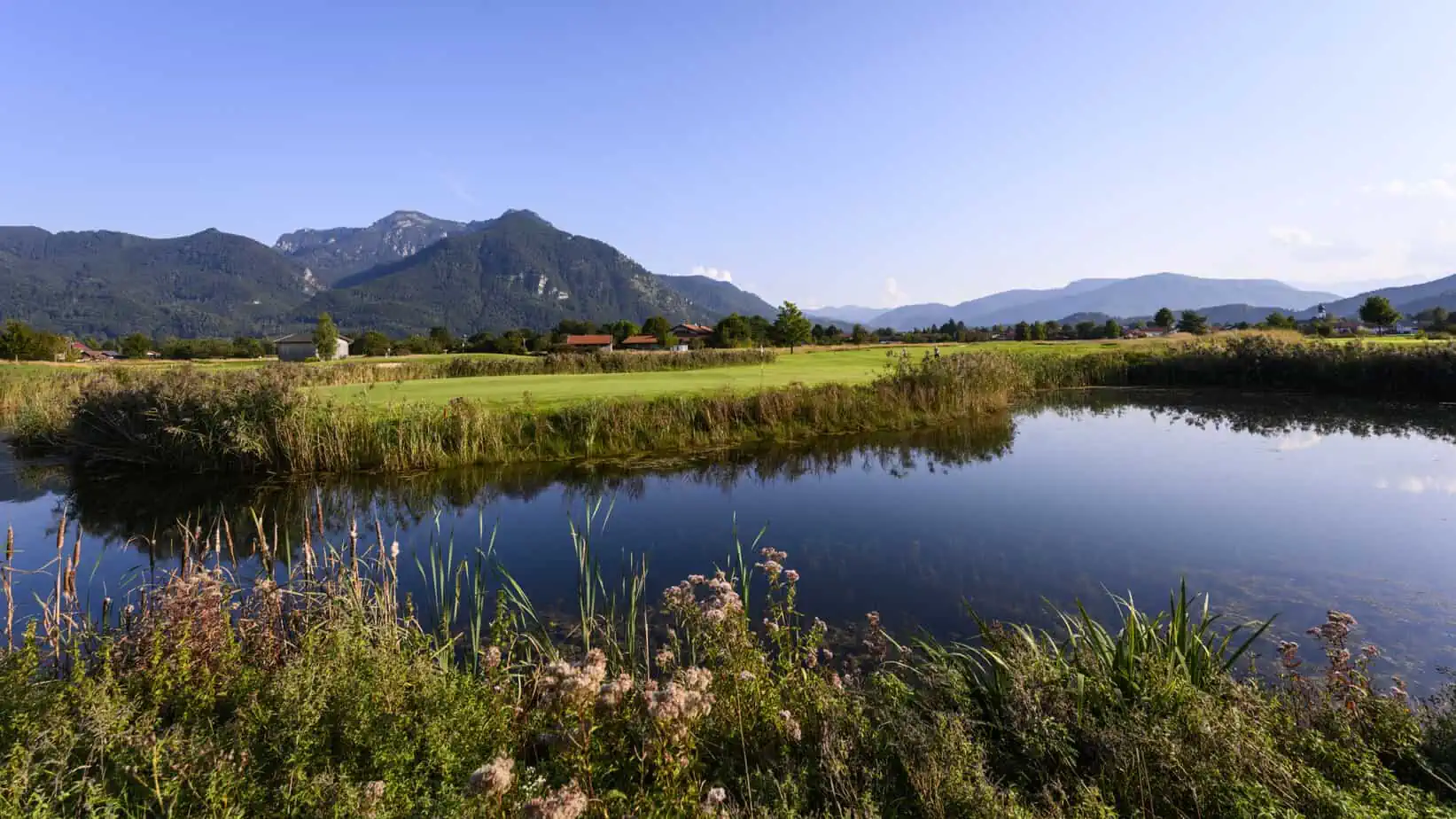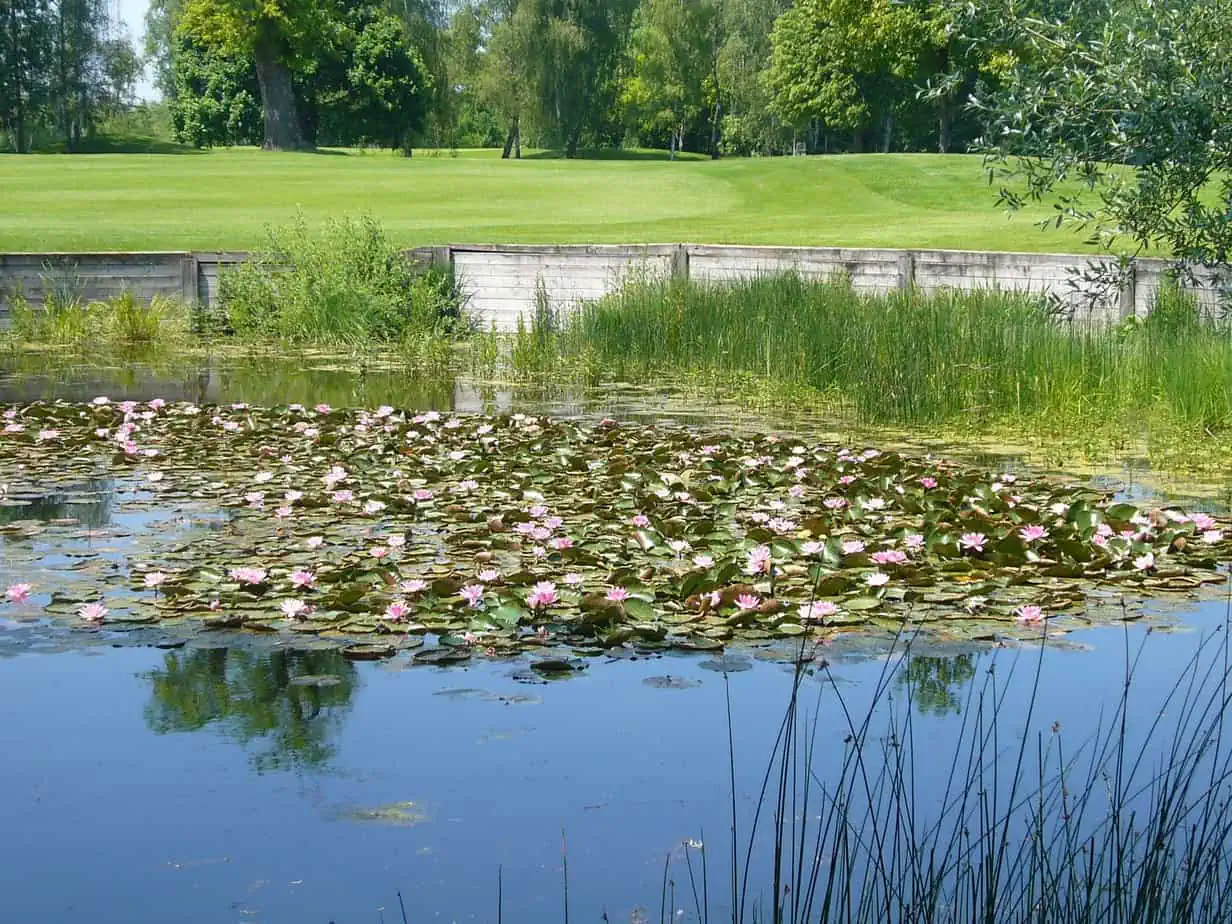Creating and maintaining ponds correctly
Ponds and small lakes are highly complex ecosystems and of great importance for biodiversity. Both outside and directly on golf courses, as Dr. Gunther Hardt, Head of the Biodiversity Working Group of the German Golf Association (DGV), emphasizes. “There are very valuable types of biotope for animals. They also have a high ecological value for many plants.”
At the same time, however, he also emphasizes that bodies of water that are divided into still and flowing waters require special care. “The entire water ecology has to be right, and a lot is done wrong on golf courses due to ignorance. Some ponds look nice, but are not designed sustainably.”
Unbalanced ecosystems
If not done properly, ecosystems can quickly become unbalanced. Still waters (e.g. a pond) then have to be extensively and expensively rehabilitated. It is therefore important to prevent a pond from “tipping over” and achieving a negative oxygen balance. Nutrient input into the water from grass cuttings, fallen leaves or waterfowl droppings should be removed regularly. In addition, the entry of fertilizers should be prevented as a matter of principle. In addition, stirring up the sediment layers at water temperatures above twelve degrees Celsius should be avoided. The same applies to a warming of the shallow water temperature, which results in a reduced ability to bind oxygen. Ponds in the shade of trees (e.g. willow, alder, poplar) and shrubs have an advantage from this point of view. However, deciduous trees should grow at least six meters away from the bank due to the falling leaves and root formation.
Correct fish stocking
Consistent fish stocking of water bodies also plays a major role for the ecosystem. Too many fish that are intended for fishing are just as counterproductive as koi and their hybrids, which constantly rummage through the bottom of the water in search of food and thus repeatedly flush nutrients into already nutrient-saturated water surfaces. This accelerates the so-called eutrophication. The ratio of peaceful fish to predatory fish must also be right and the introduction of foreign fish species is prohibited in many countries. The use and monitoring of crayfish and pond mussels should only be carried out by accredited specialist institutions.
Vegetation strips, depth and unnecessary fountains
When designing ponds, Hardt also recommends paying just as much attention to the design of the vegetation around the edges as to the necessary depth of the body of water. “If this is right, the water cycle works by itself,” says the specialist. Energy and cost-intensive water fountains could then be avoided, especially because of the evaporation rate and the often opposite effect of water circulation and heating in shallow ponds.
Andreas Klapproth, head of the golf course irrigation working group at the German Golf Federation, puts the required depth of a pond at between two and six meters. A width of one to two meters is recommended for the vegetation strips in the form of grass or herbaceous and shrub vegetation. “Grass is completely wrong,” says Hardt. The shallow water areas should be overgrown (e.g. purple loosestrife, iris, marsh marigold, limited reed and bulrush areas, sedges, rushes). The plantings should be on the side facing away from the play area.
Pond size and storage ponds
According to Klapprath, many factors are decisive in determining the size of the pond, such as storage requirements, availability of space, slope of the terrain and budget. The calculation formula with the three factors average daily water demand, bridging period/days and storage volume in m³ is used to determine the storage volume required to bridge water shortages during the main irrigation period.
In addition, the pond should not be designed like a “bathtub”, but should contain elevation steps and be curved rather than smooth at the edge of the bank, as Dr. Uta Cascorbi suggests in a webinar by the German Greenkeeper Association on the structure and maintenance of still waters in February 2024. The Suisse biodivers.ch platform offers a good guide to planning still waters. As a rule of thumb, according to Cascorbi, the proportion of swamp zones, shallow water zones and deep water zones can be considered to be one third each, provided that the reed zone, the floating leaf zone and underwater plant zone as well as the open water zone with phytoplankton as oxygen producers are taken into account. According to Hardt, classic reservoir ponds should be planted along the same lines as other bodies of water.
Maintenance measures and external contacts
The vegetation strips should be maintained in stages, just like other parts of the site, so that animals can retreat to other areas after the strips have been mown. Due to high temperatures, many ponds have problems with increased algae growth and above-average growth of aquatic plants, which can lead to eutrophication in extreme situations with high nitrate and phosphate levels in the water. Water mowing is recommended here.
It is not always possible to prevent the ponds from silting up after a period of 20 to 30 years. In such cases, the banks are often desilted or redesigned. This requires a permit from the authorities (mandatory, especially for foil ponds). Here, German golf course operators should get local water wardens from fishing clubs or district fishing advisors, the regional environmental agency, the water management department and the lower nature conservation authority on board. “Golf courses are well advised to seek help here,” says Hardt.
In order to recognize changes and possible problem developments in good time, water areas should also be sampled regularly. For such a water analysis, standard values such as pH value, conductivity, total hardness, oxygen, phosphate, ammonia, nitrate, nitrite and BOD5 (biological oxygen demand/5 days) are determined.
Be careful with lakeball divers and remedies
Many golf course operators are also often faced with the question of how best to remove balls that have been shot into the water. Companies that arrive with so-called lakeball divers are not ideal in every case. Especially if a diving operation takes place on days when the water temperature is above ten degrees. Here the soil is stirred up and the balance is thus permanently impaired. “It can backfire,” warns Hardt. “I therefore advise against it at certain times.”
Tips for preserving the biodiversity of a body of water:
- Planning a pond is crucial. The most important parameters such as location, size, depth, planting and fish stocking should be taken into account here.
- Proper planting in the different zones is important in order to create a suitable ratio between the shallow water area (nutrient layer) and the deep water area (toe layer).
- The vegetation area around the body of water must be well planned.
- Sustainable and professional maintenance of all areas around bodies of water is important.
- Networking with the most important experts, institutes and authorities/offices is necessary.









